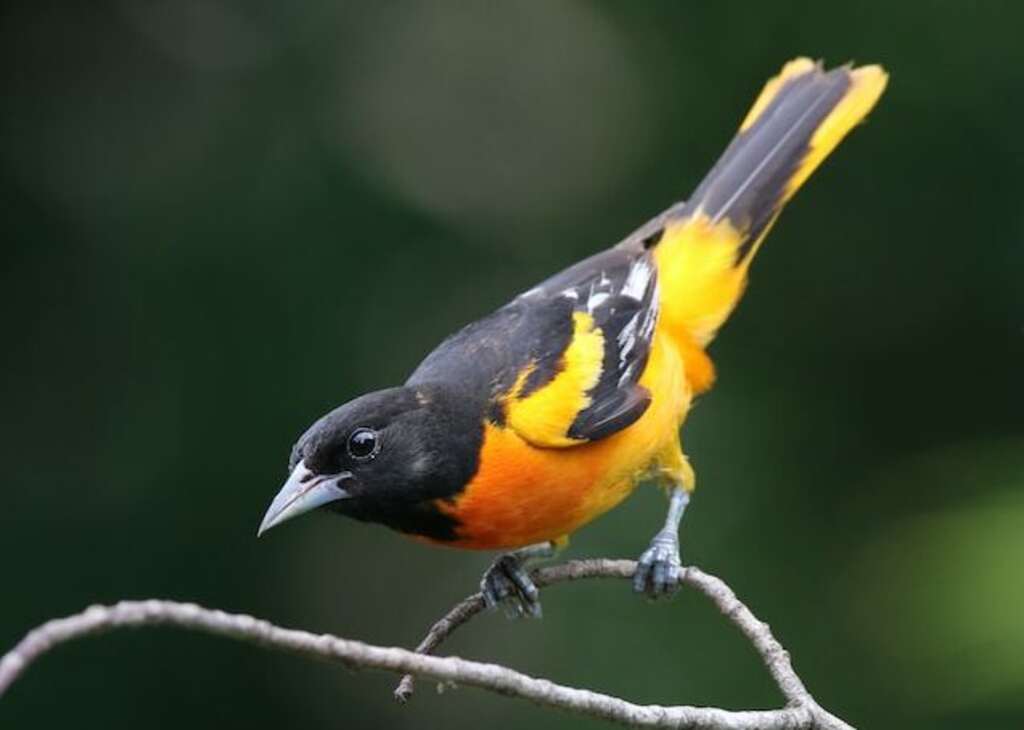Welcome bird enthusiasts! Today, we embark on a journey to uncover the dietary habits of Baltimore Orioles. Join us as we delve into the question: Do Baltimore Orioles Eat Ants? Prepare to uncover the truth behind this fascinating aspect of avian behavior.
Table of Contents
- 1 Protecting Backyard Birds: Ants, Bugs, and Bird Feeder Solutions
- 2 Understanding the Diet of Baltimore Orioles
- 3 Do Baltimore Orioles Eat Ants?
- 4 Impact of Ants on Feeding Behavior of Baltimore Orioles
- 5 Role of Bird Feeders in Attracting Ants to Baltimore Orioles
- 6 Tips to Prevent Ants from Invading Oriole Feeders
- 7 Comparing Different Types of Ant Repellents for Oriole Feeders
- 8 Best Practices for Protecting Baltimore Orioles from Ant Infestation
- 9 Do Baltimore Orioles Eat Ants?
- 10 Author
Protecting Backyard Birds: Ants, Bugs, and Bird Feeder Solutions
Backyard feeders can attract not only Baltimore Orioles but also hummingbirds and indigo bunting. Interestingly, Baltimore Orioles also have a taste for oranges and ants.
Ants can be a problem for orioles, hummingbirds, and woodpeckers, especially when they are trying to feed on insects or nectar from flowers or backyard feeders.
Ants can crawl up the stems of plants and trees where the birds are feeding, making it difficult for them to access their food sources.
This is particularly concerning for baby orioles, young orioles, and hummingbirds who are more vulnerable to predators, including ants and other small birds.
Bugs can also attract ants to the feeder, posing a threat to the birds.
One solution to keep bugs away from hummingbirds and orioles at backyard feeding stations is using ant moats.
Ant moats are small containers filled with water that can be attached to hummingbird feeders and even flower pots.
The water creates a barrier that ants cannot cross, keeping them away from the birds’ food sources.
But Baltimore Orioles, woodpeckers, and indigo buntings aren’t the only bird species facing challenges from predators, ants, and other bugs while feeding on nectar from flowers and berries.
Hummingbirds also have to deal with these pests and larvae. Using an ant moat can help keep these insects at bay and protect these beautiful birds.
In addition to ants, Baltimore Orioles also eat bugs such as caterpillars as part of their diet. Caterpillars provide essential nutrients that help baby orioles and small birds grow strong and healthy.
However, caterpillars can also be harmful if they contain toxins from the plants they’ve been feeding on. Hummingbirds are also predators that feed on bugs for their protein needs.
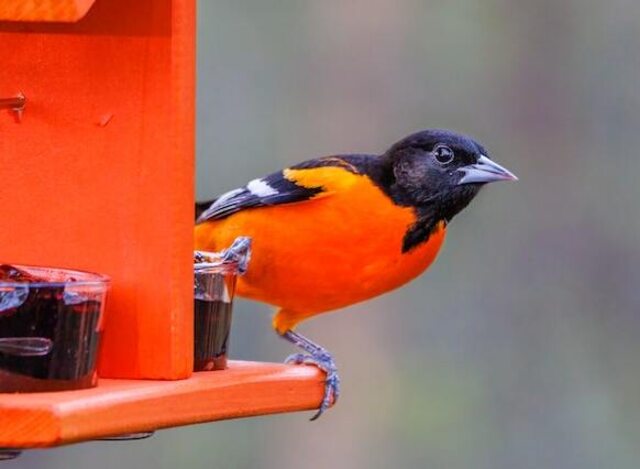
Understanding the Diet of Baltimore Orioles
Baltimore Orioles and hummingbirds are beautiful birds that are known for their bright orange plumage and melodious songs.
These birds, along with woodpeckers, are a common sight in many parts of North America, especially during the spring and summer months.
If you’re interested in attracting these lovely creatures to your backyard feeding stations, it’s important to understand their diet.
In addition to nectar, Baltimore Orioles and hummingbirds also feed on bugs, so providing them with a variety of foods will keep them coming back.
A Diverse Diet
Baltimore Orioles have a diverse diet that includes insects, fruits, and nectar. They are particularly fond of caterpillars, which they feed to their young during nesting season.
Other insects that Baltimore Orioles eat include spiders, ants, aphids, and beetles. These birds prefer ripe berries such as mulberries, raspberries, and blackberries.
They also enjoy sweet nectar from flowers like trumpet creeper and jewelweed.
Hummingbirds, on the other hand, can be attracted by placing a hummingbird feeder filled with sweet orange nectar at designated feeding stations.
Feeding Orioles
One way to attract Baltimore orioles and hummingbirds to your yard is by offering them sugary foods like jelly, fruits, and oranges.
Orioles and hummingbirds love these treats because they provide a quick burst of energy. To feed them jelly, fruits, or oranges, simply place them in a shallow dish or on a flat surface like a plate.
You can also use specially designed feeders with feeding ports and a high perch that have clear bottoms, so the birds can see the food inside.
Clear-bottomed hummingbird feeders are preferred over opaque ones because they allow the hummingbirds to see how much nectar is left inside without having to probe around with its beak.
If you decide to offer grape jelly as one of your treats for the birds, feeding orioles with a 100% natural brand is recommended since some brands contain high fructose corn syrup, which isn’t healthy for birds.
Consider using a WBU oriole feeder for optimal feeding results.
Ants Not A Significant Part Of Their Diet
While Baltimore Orioles do eat ants, they are not a significant part of their diet. These birds prefer other insects like caterpillars and beetles, which provide more protein and nutrients.
If you’re interested in attracting Baltimore Orioles to your yard, it’s better to focus on offering them foods that they enjoy, such as fruits like oranges, and nectar from a hummingbird feeder.
Additionally, this feeder will also attract hummingbirds to your yard.

Do Baltimore Orioles Eat Ants?
Diverse Diet of Baltimore Orioles
Baltimore Orioles are known to have a diverse diet that includes insects, fruits, and nectar. These birds are migratory and can be found in the eastern half of North America during the breeding season.
They prefer open woodlands, forest edges, and gardens with tall trees for nesting. Baltimore Orioles are brightly colored with black and orange plumage, making them easy to spot among leaves.
Hummingbirds, on the other hand, are attracted to nectar and can be enticed to visit your garden by providing a hummingbird feeder with feeding ports and a high perch.
Insects make up a significant portion of feeding new world and old world orioles. Baltimore Orioles feed on a variety of insects such as caterpillars, beetles, grasshoppers, spiders, and ants.
However, ants are not their preferred food source but may consume them if other food sources are scarce. Hummingbirds also have a similar diet to orioles.
Accidental Consumption of Ants
Baltimore Orioles may accidentally eat ants while foraging for insects or fruits on high perches. These birds have a unique way of feeding where they hang upside down from branches to reach their food, much like hummingbirds.
While doing so, they may come across an ant nest and inadvertently ingest some ants along with their intended prey. To attract Baltimore Orioles, try using an orange-colored hummingbird feeder on a high perch.
Ants do not provide significant nutritional value for Baltimore Orioles since they have low protein content compared to other insects like caterpillars or grasshoppers that these birds prefer.
Therefore, ants are not a primary food source for these birds. However, Baltimore Orioles can be attracted to high perches near hummingbird feeders filled with orange nectar solution.
Predators of Baltimore Orioles
Baltimore Orioles face several predators in the wild such as hawks, owls, snakes, and domestic cats. Hawks and owls hunt these birds during daylight hours while snakes prey on them at night when they roost in trees.
Orioles can avoid some of these predators by perching high on trees or using a moat around their hummingbird feeder.
Domestic cats pose a threat to Baltimore Orioles and hummingbirds, since they often hunt small birds like these that visit backyard bird feeders or nest near human dwellings.
Providing a high perch for birds to rest and offering a nectar solution can help attract them while keeping them safe from predators.

Impact of Ants on Feeding Behavior of Baltimore Orioles
Ants are a common sight in many parts of the world, and it’s natural to wonder if they play a role in the feeding behavior of birds like the Baltimore Oriole.
While ants may occasionally be part of an oriole’s diet, they are not a significant food source for these birds.
However, to keep ants away from their preferred food source, the nectar solution, Baltimore Orioles may use a hummingbird feeder placed on a high perch.
Ants Are Not a Significant Part of the Baltimore Oriole’s Diet
Baltimore Orioles feed primarily on insects and fruits, often perching high to find their prey. They prefer insects such as caterpillars, beetles, and grasshoppers over ants.
According to research conducted by ornithologists, ants account for less than 1% of an oriole’s diet.
While they may occasionally snack on small birds, Baltimore Orioles are known to enjoy feeding from hummingbird feeders.
Ants Can Disrupt the Feeding Behavior of Orioles by Competing for Food Sources
While ants may not be a primary food source for Baltimore Orioles, they can disrupt their feeding behavior by competing for food sources.
Ants are known to swarm around fruit trees and other plants that produce sugary substances that orioles enjoy eating.
When this happens, orioles may avoid these areas altogether or spend less time there. Additionally, ants can also be a nuisance around hummingbird feeders and prevent orioles from accessing the nectar.
Orioles prefer to feed from a high perch, but ants crawling up the pole can make it difficult for them to do so.
Some Orioles Use Ants to Help Protect Their Nests from Predators
Despite their relatively minor role in feeding orioles, some species use ants to help protect their nests from predators.
These birds will smear ant secretions around their nest entrances as a deterrent against potential intruders like snakes and squirrels.
Additionally, providing a hummingbird feeder can also attract orioles to your yard for easy viewing.
The Presence of Ants Can Also Attract Other Bird Species That Feed on Them
While Baltimore Orioles themselves do not rely heavily on ants as a food source, other bird species do. For example, woodpeckers and nuthatches are known to feed on ants regularly.
When there is an abundance of ants in an area, these birds may be attracted to it, which could indirectly impact the feeding behavior of Baltimore Orioles.
However, if you want to attract Baltimore Orioles to your yard, consider setting up a hummingbird feeder.
Role of Bird Feeders in Attracting Ants to Baltimore Orioles
Sweet nectar-filled bird feeders are a popular way to attract Baltimore Orioles and hummingbirds. However, it is not just the birds that are attracted to these feeders – ants are also drawn to the sweet liquid.
In this section, we will discuss the role of bird feeders in attracting ants to Baltimore Orioles and hummingbirds, and ways to prevent ant infestations.
Bird Feeders Can Attract Ants to Baltimore Orioles
Ants are attracted to sweet substances, and feeding orioles with hummingbird feeders provide just that. The sugar water or nectar in the feeder can be irresistible for ants looking for a quick meal.
Moreover, if the feeder is not properly maintained and cleaned regularly, it can become a breeding ground for ants.
Oriole Feeders with Leaking Nectar Can Attract More Ants
If an oriole feeder is leaking nectar, it can attract even more ants. The sugary liquid dripping from the feeder can create a trail of sugary scent leading straight to your bird feeder.
This can cause an ant infestation around your feeder area, which could also attract hummingbirds.
Ants Can Be Deterred from Bird Feeders by Using Ant Moats or Traps
One effective way of keeping ants away from your hummingbird feeder is by using ant moats or traps. An ant moat is a barrier that surrounds your hummingbird feeder and provides an obstacle course for any approaching ants.
It works by filling the moat with water, which creates a barrier that prevents ants from reaching the food source.
Keeping Bird Feeders Clean and Free of Debris Can Also Help Prevent Ant Infestations
Regular cleaning of your hummingbird feeders can prevent ant infestations as well as keep your feathered friends healthy. Hummingbirds may avoid dirty feeders, causing them to leave your yard altogether.
Therefore, make sure you clean out any old food debris and rinse off all parts of the feeder before refilling with fresh nectar.
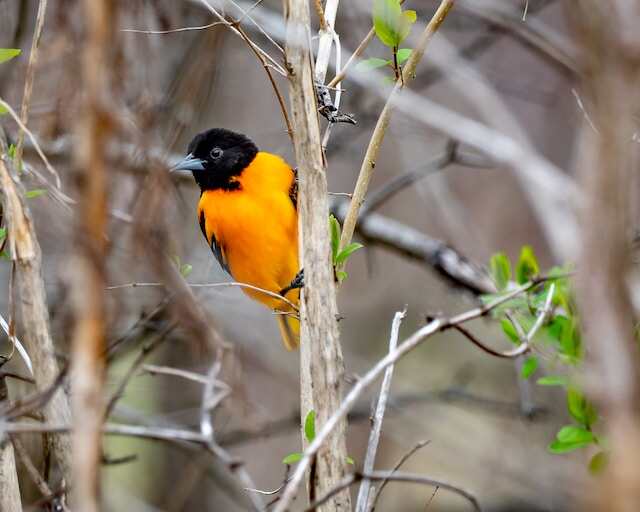
Tips to Prevent Ants from Invading Oriole Feeders
Regular Cleaning of Oriole Feeders
To prevent ants from invading your oriole and hummingbird feeders, it is essential to clean them regularly. The spilled nectar or seeds can attract ants and other insects that can harm the birds.
You can use a mild soap solution and a brush to scrub the feeding ports and other parts of the feeder. Rinse thoroughly with water and let it dry completely before refilling it with fresh food.
Ant Moats or Traps
Ant moats or traps are an effective way to keep ants away from your oriole feeders. These devices work by creating a barrier between the feeder and the ground, preventing ants from crawling up the pole or chain.
Ant moats are small cups that you fill with water, while ant traps contain a sticky substance that traps insects.
Planting Ant-Repelling Herbs or Flowers
Another way to deter ants from invading your backyard feeding stations, such as your hummingbird feeder or WBU oriole feeder, is by planting ant-repelling herbs or flowers nearby.
Mint, lavender, basil, and marigold are some examples of plants that have been known to repel ants naturally. These plants emit strong scents that mask the smell of sugary foods and deter insects.
Choosing an Oriole Feeder
When choosing an oriole feeder, look for one that has bee guards and ant moats built-in. Bee guards prevent bees from accessing the nectar while still allowing birds to feed comfortably. Ant moats create a physical barrier between the feeder and any crawling insects.
Placing Your Oriole Feeder
The location of your oriole feeder plays a significant role in preventing ant invasions. Place your feeder in an open area away from trees, fences, walls, and other objects where ants can climb up easily.
Make sure there are no tree branches hanging over the feeder as they may provide easy access for squirrels.
Making Oriole Food
Orioles love sweet foods such as nectar, jelly, and fruit. You can make your own nectar by mixing four parts water with one part white granulated sugar.
Boil the mixture for two minutes, let it cool down, and then fill your feeder with fresh nectar. Avoid using honey as it can ferment quickly and cause harm to the birds.
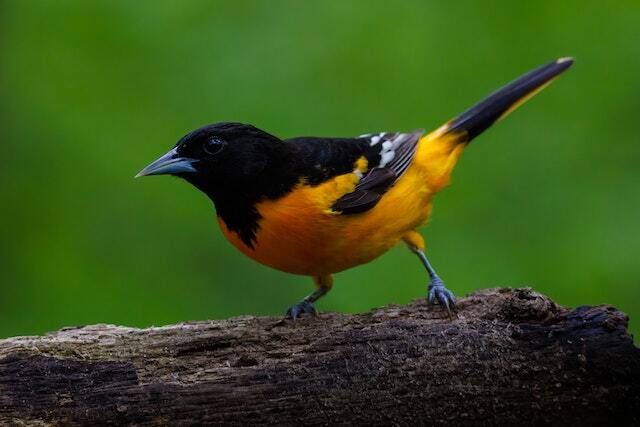
Comparing Different Types of Ant Repellents for Oriole Feeders
Different Types of Ant Repellents for Oriole Feeders
Orioles are beautiful birds that are known to be attracted to a variety of foods, including fruit, nectar solution, grape jelly, and suet.
However, one problem that people often face when setting up oriole feeders is the presence of ants. Fortunately, there are different types of ant repellents that can be used for oriole feeders.
One popular option is the use of hummingbird feeders as oriole feeders.
The WBU decorative window hummingbird feeder is a great choice for this purpose, since it has a built-in ant moat that prevents ants from crawling into the feeder and contaminating the food.
This feeder also has suction cups that allow it to be attached to windows for easy viewing.
Another effective method for keeping ants away from oriole feeders is by using an ant guard. These guards are placed above the feeder and act as a barrier between the ants and the food.
They come in different shapes and sizes, but typically consist of plastic cups with water inside them.
Aside from using ant repellents, it’s important to clean oriole feeders regularly with top shelf dishwasher and rainwater. This helps prevent mold growth and bacterial contamination which can harm the birds’ health.
In addition to eating fruit and nectar solutions, Orioles also enjoy seeds and suet during colder months when insects are scarce.
It’s important to offer a variety of foods throughout the year, including hummingbird feeders, to keep these birds coming back.
Best Practices for Protecting Baltimore Orioles from Ant Infestation
Ants are a common problem that Baltimore Oriole enthusiasts face. These tiny insects can be a nuisance to these beautiful birds, as they steal nectar from their feeders and even crawl into their nests.
However, there are several best practices that you can follow to protect Baltimore Orioles from ant infestation.
Choose an Ant-Proof Feeder
One of the most effective ways to keep ants away from Baltimore Oriole feeders is by choosing an ant-proof feeder. Look for a feeder with moats or slippery surfaces that prevent ants from climbing up.
The moat acts as a barrier between the nectar and the ants, making it difficult for them to reach the feeder.
Some feeders come with slippery surfaces like Teflon coating or oil, which makes it hard for ants to climb up.
Apply Sticky Barrier
Another effective way to deter ants is by applying a sticky barrier around the feeder pole or hanging it from a fishing line coated with petroleum jelly.
This method works by creating an obstacle that prevents ants from reaching the food source. The sticky substance on the pole or line traps any crawling insect and prevents them from reaching their destination.
Remove Ants Manually
If you notice ants have already invaded your Baltimore Oriole’s nest or feeder, remove them manually and clean the area with soapy water or vinegar to eliminate their scent trail.
It is important not to use insecticides near bird feeding areas as they may harm birds directly or indirectly through contaminated food sources.
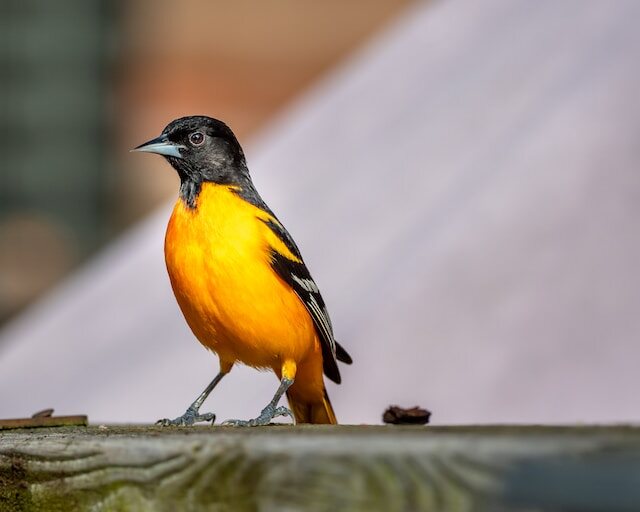
Do Baltimore Orioles Eat Ants?
In conclusion, Baltimore Orioles do eat ants. While they are not a primary food source for these birds, ants can provide a valuable source of protein and other nutrients.
However, it is important to be mindful of the potential impact that ants can have on the feeding behavior of Baltimore Orioles.
Ants can quickly infest bird feeders and scare off orioles, making it difficult for them to access their preferred foods.
To prevent ant infestations at bird feeders, there are several steps that you can take.
First, consider using an ant moat or other type of barrier to keep ants away from the feeder itself. Be sure to clean your feeder regularly and remove any spilled seed or debris that could attract ants.
If you do notice an ant infestation at your feeder, there are several types of repellents that you can use to discourage them from returning.
These include natural remedies like cinnamon or peppermint oil as well as commercial products designed specifically for use around bird feeders.
Ultimately, by taking steps to prevent ant infestations and protect Baltimore Orioles from these pests, you can help ensure that these beautiful birds continue to thrive in your backyard.
So if you want to attract these colorful songbirds to your feeder this season, be sure to keep an eye out for signs of ant activity and take action as needed!

